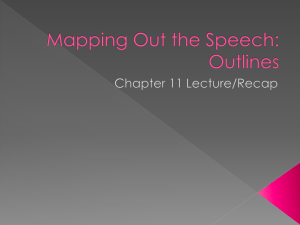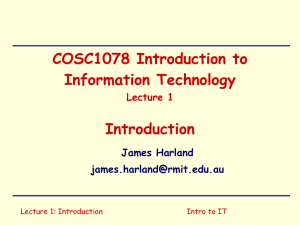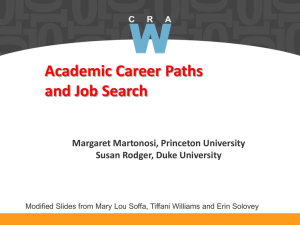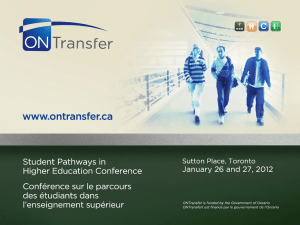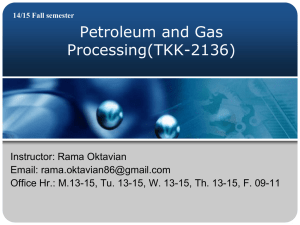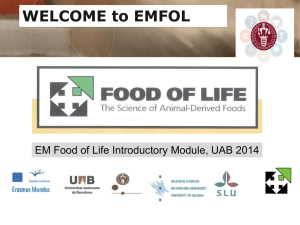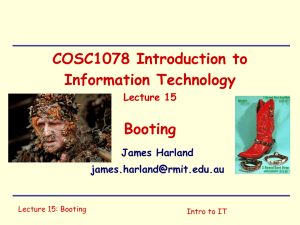Data Storage Devices
advertisement
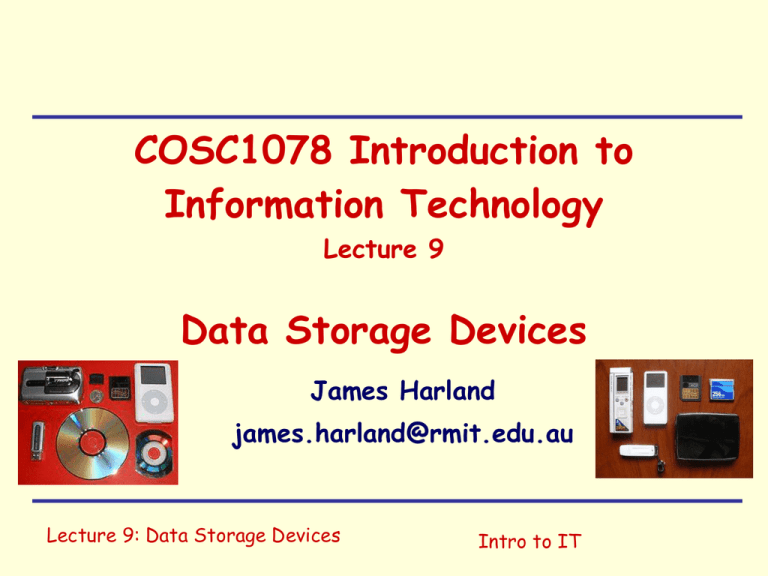
COSC1078 Introduction to Information Technology Lecture 9 Data Storage Devices James Harland james.harland@rmit.edu.au Lecture 9: Data Storage Devices Intro to IT Introduction Who is this bloke? Lecture 9: Video Intro to IT Introduction Lecture 9: Data Storage Devices Intro to IT Overview Questions? WebLearn Test 1 Assignment 1 Binary Representation Questions? Lecture 9: Video Intro to IT Introduction to IT 1 Introduction 2 Images 3 Audio 4 Video WebLearnTest 1 5 Binary Representation Assignment 1 6 Data Storage 7 Machine Processing 8 Operating Systems WebLearn Test 1 9 Processes Assignment 2 10 Internet 11 Internet Security WebLearn Test 3 12 Future of IT Assignment 3, Peer and Self Assessment Lecture 9: Audio Intro to IT Questions? How did you spend 6-8 hours on this course last week? This week? Lecture 9: Video SE Fundamentals Assessment Process Submit all assignments via Blackboard in the Learning Hub Assignment 1 due 11.59pm Sunday 1st April Assignment 2 due 11.59pm Sunday 6th May Assignment 3 due 11.59pm Sunday 27th May Late assignments attract a penalty of 10% per day late, up to a maximum of 50% Lecture 9: Video Intro to IT Assignment Assignment will be in three parts Overall task is to produce a video Groups of up to 3 Assessed by final video and group blog Part 1: images and audio (end of week 5) Part2: hardware (end of week 9) Part 3: reflection, research (end of week 12) Lecture 9: Video Intro to IT Assignment 1 Use GIMP (or a similar tool) to perform some manipulations on an image Use Audacity to perform some manipulations on sound Use a movie making tool to produce something like (and much better than!) ‘Lord of the Controllers 1 & 2’ Email me your group and its name so that I can set up a blog on the Learning Hub Lecture 9: Video Intro to IT Overview 01010100001010101010100110100010101001101001010010 100011100010101010100101111001001010… Lecture 9: Data Storage Devices Intro to IT What do computers do? Compute! Input/Output Processing Memory Lecture 9: Data Storage Devices Intro to IT History … Babbage’s Difference Engine (1849) Babbage’s Analytical Engine (1837-1871, never built) Turing’s Universal Machine (1936, mathematical model) Turing digital Boolean-logic multiplier (1937) Colossus (1943, destroyed 1945) ENIAC (1946) Von Neumann architecture (c. 1945) EDVAC (1949) CSIRAC (1949) Lecture 9: Data Storage Devices Intro to IT Overview “Thomas the Tank Engine” Lecture 9: Data Storage Devices Intro to IT Overview Video Audio Text Thumbnails Lecture 9: Data Storage Devices Intro to IT Memory via `Flip flops’ 0 or 0 0 0 0 01 and 0 1 not Lecture 9: Data Storage Devices Intro to IT Memory via `Flip flops’ 01 or 1 1 1 1 and 1 0 not Lecture 9: Data Storage Devices Intro to IT Memory via `Flip flops’ Can design other versions of flip-flops Shows how circuits can be designed using AND, OR, NOT (NAND, NOR, XOR, …) in combinations (gates) Hierarchy and abstraction Shows how electric circuits can store values Lecture 9: Data Storage Devices Intro to IT Computer Memory Cells of 8 bits each (one byte) … Most significant bit address Lecture 9: Data Storage Devices … Least significant bit Intro to IT Random Access Memory (RAM) Random access means any cell can be accessed at any time (and in any order) Volatile – contents cleared when machine is switched off Very fast compared to other forms of memory DRAM: dynamic RAM (replenishes charges constantly) SDRAM: synchronous DRAM – faster still Often have small very fast caches and registers Lecture 9: Data Storage Devices Intro to IT Magnetic Disk Thin spinning metal disk with magnetic coating Each disk contains a number of circular tracks Often several disks stacked on top of each other Cylinders made up of tracks made up of sectors Can have very large storage this way Slow access time! Lecture 9: Data Storage Devices Intro to IT Magnetic Disk (Hard Disk) Seek time: move heads from one track to another Latency time: half time for complete disk rotation Access time: seek time + latency time Transfer rate: rate data can be read from disk `Typical’ Hard disk Seek time: 2ms to 15ms Latency time: 8ms to 20ms Transfer rate: 0.5 GB per second Sounds fast, but is actually quite slow … Lecture 9: Data Storage Devices Intro to IT Optical Disks (CDs, DVDs) Laser readers rather than magnetic ones Disks more error-tolerant than magnetic ones Type Features Date Storage CD “compact disk” 1984 800MB DVD Multiple layers 1995 15GB Blu-ray `blue laser’ 2004 100GB (405 vs 650 nm) Lecture 9: Data Storage Devices Intro to IT Flash Drives Disks of all sorts are slow compared to other circuits Flash drives ‘write’ small electronic circuits Eventually decay after many changes of data Suitable for slow-changing data, not main memory Portable and much more resilient than disks Lecture 9: Data Storage Devices Intro to IT Older Storage Types Magnetic tape `Floppy’ disk (5.25’’ disk) 3.5’’ disk Lecture 9: Data Storage Devices Intro to IT Conclusion Get Assignment done this week Don’t forget to blog … Keep reading! (book particularly) Lecture 9: Data Storage Devices Intro to IT

